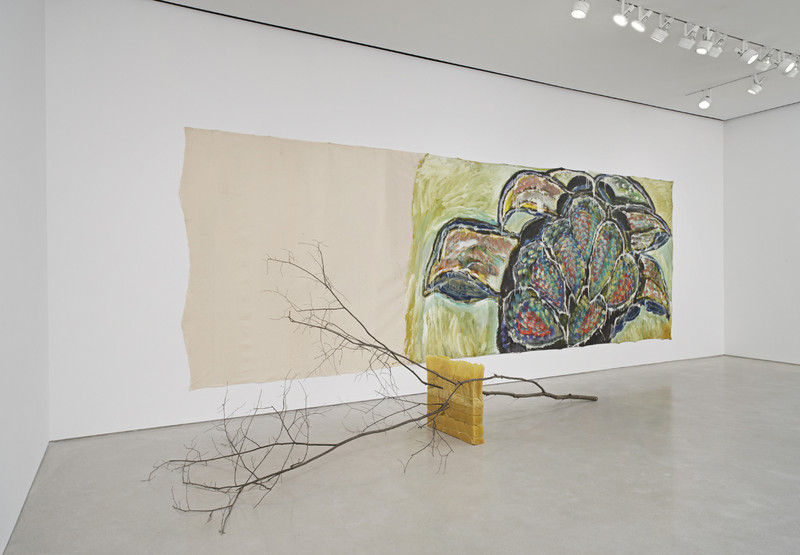Mario Merz
01 Nov - 22 Dec 2012
MARIO MERZ
Major Works from the 1980s
1 November - 22 December 2012
New York, NY: 3 October 2012 - Sperone Westwater is pleased to announce an exhibition of vintage works by Italian artist, Mario Merz (1925 - 2003). This is the artist’s eighth solo show at the gallery, and features three major paintings and one sculpture from the early 1980s. The exhibition is on view 1 November through 22 December 2012.
A principle member of the Arte Povera group in the late 1960s, Merz possessed an anti-elitist aesthetic. In his work, he utilized accessible and unconventional materials from everyday life, as well as organic and inorganic debris. The rapid industrialization of northern Italy in the second half of the 20th century gave rise to an interchangeable association between the natural environment and architecture. This relationship, in addition to the disciplines of science and mathematics, are consistently prevalent in Merz’s alchemical art.
Central to Merz’s work is the Fibonacci progression – a numerical sequence where each number is the sum of the previous two numbers. Merz translates this natural system of proliferation and growth in his art, referring to it as “an intensified life.” Wandering Songs I (Canti errabondi I) (1983), an acrylic and oil painting with leaves and pine cones, spans over twenty-five feet across: a tense, powerful energy is generated with bold gestures of colorful, impastoed paint that cover over half of the canvas, while the rest is left exposed. The artist also incorporates the architecture of the space by positioning a block of beeswax and an untamed branch in the foreground, breaking the geometric composition of the canvas.
In Le Foglie (The Leaves) (1983-84), measuring over 26 feet across, gold leaf squares are scattered around two large asymmetrical leaf-like forms. The reflective qualities of the gold leaf and enamel add intensity and depth to the surface. In 1967, Merz said:
The leaves were enormous only because I realized that walls were big and leaves were attaching themselves to walls. I wanted to do a painting that would relate to the wall, not just to its internal image; and so the internal image adapted itself to the external relationship.
Merz’s lifelong exploration of man’s constantly changing relationship with nature is encapsulated in Pianissimo (very slowly, very softly) (1984). In this work, a Plexiglas and steel cabinet elegantly cages a convergence of beeswax and pine cone. The wax, as a natural product and material long used by artists for casting, is shaped as a cone and inverted on a pole. With this, Merz suggests a drill into the earth or a weapon used in battle. Merz further emphasizes the connection between nature and man-made environments by incorporating the shape of leaves created from welded steel. Another work, the large-scale painting, L'Epoca Del Ferro (1983-85), which translates to “The Age of Iron,” – also utilizes metal with three steel strips crossing the corners of a square canvas depicting a prehistoric animal.
Major Works from the 1980s
1 November - 22 December 2012
New York, NY: 3 October 2012 - Sperone Westwater is pleased to announce an exhibition of vintage works by Italian artist, Mario Merz (1925 - 2003). This is the artist’s eighth solo show at the gallery, and features three major paintings and one sculpture from the early 1980s. The exhibition is on view 1 November through 22 December 2012.
A principle member of the Arte Povera group in the late 1960s, Merz possessed an anti-elitist aesthetic. In his work, he utilized accessible and unconventional materials from everyday life, as well as organic and inorganic debris. The rapid industrialization of northern Italy in the second half of the 20th century gave rise to an interchangeable association between the natural environment and architecture. This relationship, in addition to the disciplines of science and mathematics, are consistently prevalent in Merz’s alchemical art.
Central to Merz’s work is the Fibonacci progression – a numerical sequence where each number is the sum of the previous two numbers. Merz translates this natural system of proliferation and growth in his art, referring to it as “an intensified life.” Wandering Songs I (Canti errabondi I) (1983), an acrylic and oil painting with leaves and pine cones, spans over twenty-five feet across: a tense, powerful energy is generated with bold gestures of colorful, impastoed paint that cover over half of the canvas, while the rest is left exposed. The artist also incorporates the architecture of the space by positioning a block of beeswax and an untamed branch in the foreground, breaking the geometric composition of the canvas.
In Le Foglie (The Leaves) (1983-84), measuring over 26 feet across, gold leaf squares are scattered around two large asymmetrical leaf-like forms. The reflective qualities of the gold leaf and enamel add intensity and depth to the surface. In 1967, Merz said:
The leaves were enormous only because I realized that walls were big and leaves were attaching themselves to walls. I wanted to do a painting that would relate to the wall, not just to its internal image; and so the internal image adapted itself to the external relationship.
Merz’s lifelong exploration of man’s constantly changing relationship with nature is encapsulated in Pianissimo (very slowly, very softly) (1984). In this work, a Plexiglas and steel cabinet elegantly cages a convergence of beeswax and pine cone. The wax, as a natural product and material long used by artists for casting, is shaped as a cone and inverted on a pole. With this, Merz suggests a drill into the earth or a weapon used in battle. Merz further emphasizes the connection between nature and man-made environments by incorporating the shape of leaves created from welded steel. Another work, the large-scale painting, L'Epoca Del Ferro (1983-85), which translates to “The Age of Iron,” – also utilizes metal with three steel strips crossing the corners of a square canvas depicting a prehistoric animal.

